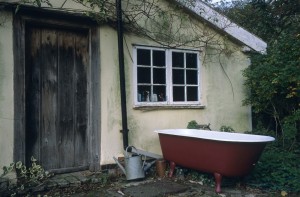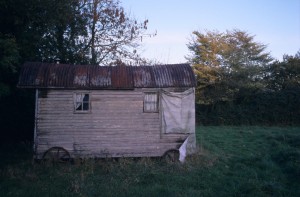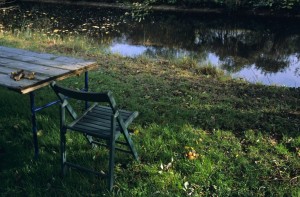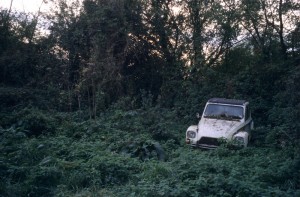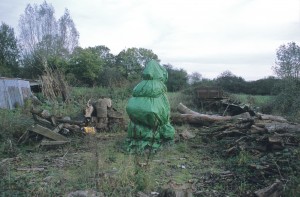by Justin Partyka
Unfortunately I never had the opportunity to meet Roger Deakin. It was always intended that our paths would cross but it didn’t quite happen: I would send him exhibition opening invitations, but I later heard that he was too busy to attend as he hurriedly worked away to finish the writing of Wildwood; and then he became ill…. So I only came to know Roger through his work and the stories I was told by mutual friends who were fortunate enough to have known him and spent time with him.
Walnut Tree Farm features prominently in Roger’s writing, which clearly reveals the important role that the place had in his life. It was a home for him in the truest sense of the word. And it was at Walnut Tree Farm that Roger dedicated almost four decades to the practice of bioregionalism, developing an intimate knowledge of his local landscape and the natural world around him. Here he swam in the moat, slept in a shepherd’s hut, crawled in the hedge, and worked the land: sawing, chopping, raking, hoeing, mowing, scything, planting, harvesting, and building. Because, as Roger wrote in his note book: “People ask how a writer connects with the land. The answer is through work.”
The passing of a life brings inevitable change, and when Roger died in August 2006 I felt that it was important to document the landscape of Walnut Tree Farm before the change arrived. A few months later, in November, I headed off to photograph there for the first time, making my way from the Wash across Norfolk towards Diss, then hopping over the border into Suffolk along the winding road to Mellis. I had been sent a map which Roger had hand drawn and I used this to guide me through Mellis common, past the post box and church to the willow tree which marked the track to Walnut Tree Farm.
When I arrived Alison Hastie sat at the kitchen table sorting through a huge pile of Roger’s note books preparing to edit the forthcoming publication Notes from Walnut Tree Farm. We had a lunch of vegetable soup, bread, cheese and pickled herring as Roger’s two cats gingerly perched on the edge of the table hoping for a taste. Alison asked about my photographs from rural East Anglia and showed me an exhibition invitation I had sent to Roger which had been lying on his desk.
I spent the afternoon wandering around the farm, exploring its twelve acres of meadows. There was a quiet stillness to the place—a melancholy which gently wept the great loss which had been bestowed upon it. But at the same time, everywhere I looked I could see Roger’s presence: it overflowed from the lush wildness encroaching every inch of the landscape; and in the material objects of shepherd huts, abandoned vehicles, his chair by the moat, the piles of wood he had chopped, and the bath tub in which he wallowed. Walnut Tree Farm is the place that Roger built, created from a deep and mutual relationship of man and the land intimately shaping each other.
Along with the landscape at Walnut Tree Farm, it was always my intention to photograph the interior of the house too, but it just never happened. I heard that things at the farm had changed, and then it was sold. A photographer’s life is full of missed opportunities.
Buy ‘Notes from Walnut Tree Farm’ here
